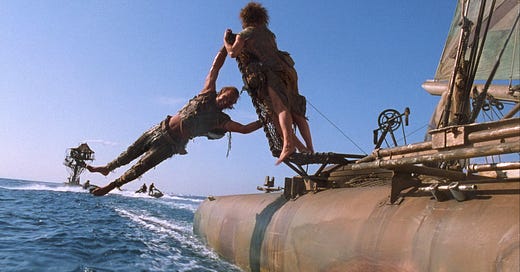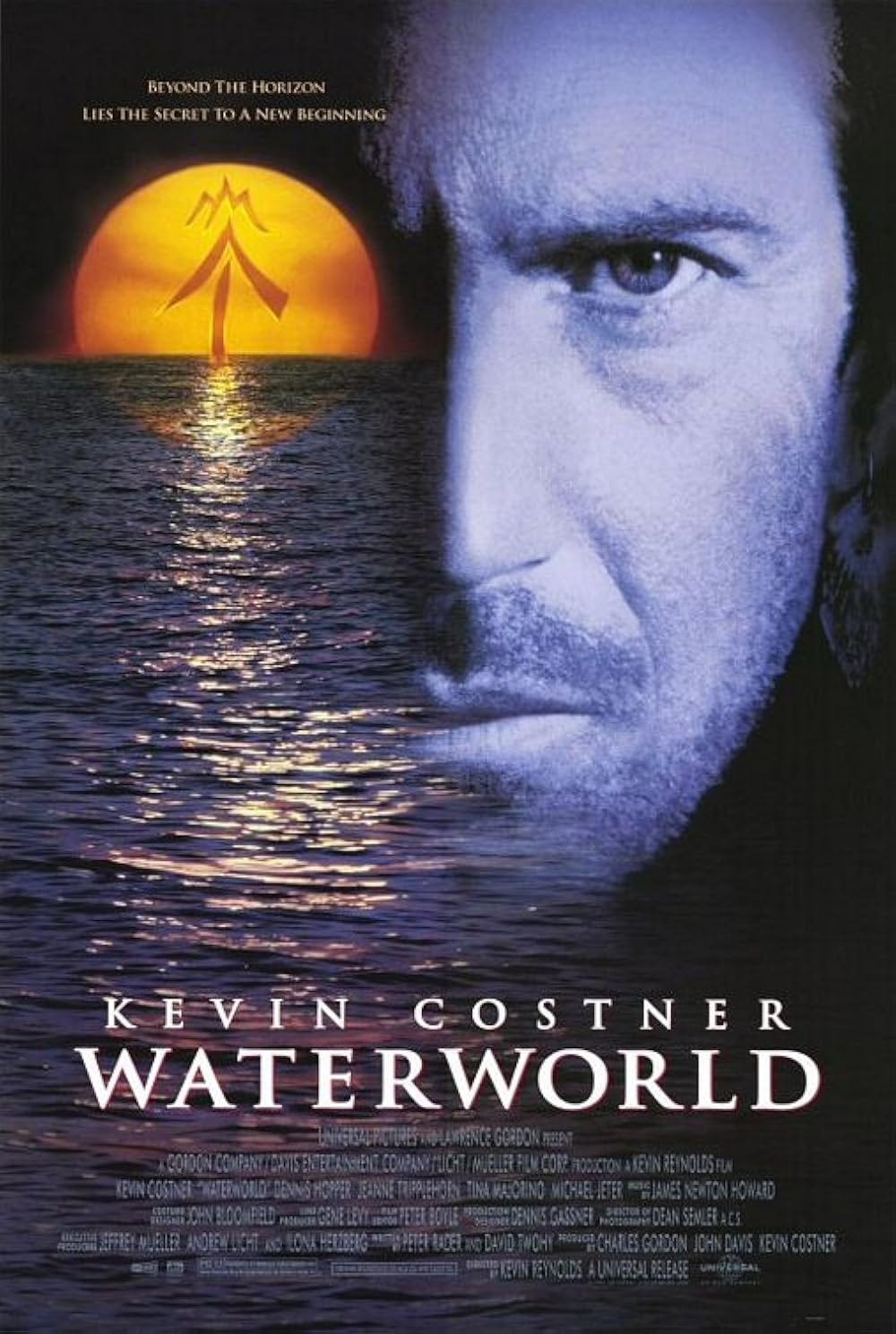Today’s issue of Dust On The VCR is a subscriber request! This infamous cinematic achievement was suggested by my dear friend Chuck Smith, one of my first new friends when I got to college—and he still tolerates me 20 years later! Chuck is the kind of friend that you can’t not hug when you see him, no matter how long it’s been since the last time, and I’m thankful to have people like that in my life. Also, if my memory serves me correctly, Chuck and I saw the original Saw together in theaters the fall of our freshman year, so with that kind of movie buddy clout, it’s only fitting that he gets a chaotic piece like this dedicated to him. Anyway. Want to request a film for a future issue? Subscribe to the paid version!
If I had to choose one word to describe Kevin Costner’s career, I think I would call it “admirable.”
Some would say he’s had a legendary run. Some will tell you he’s an acquired taste (that they have no interest in acquiring). Others, like myself, call it a mixed bag. Few film professionals have oscillated between higher highs and lower lows the way he has.1 But whether Costner is at the top or the bottom of the Hollywood dogpile, it’s hard to deny that he’s always doing something interesting. Or, well, admirable.
Waterworld is an intriguing anomaly in the history of blockbuster cinema. On the one hand, it was the ninth-highest-grossing film of 1995, raking in $264 million worldwide (even though only $88 million came from the U.S. box office). On the other hand, it was the most expensive movie ever made at the time with a price tag somewhere just south of $200 million before marketing and distribution costs.2 Throw in a largely uneven critical reception and a stray Academy Award nomination and you’ve got a film that sits curiously somewhere in between a phenomenon and a catastrophe.3
The way I see it, Waterworld is one of the greatest heat checks in Hollywood history. But it gets even more intriguing when you consider the Costner of it all.
After coming on strong in the mid-80s, Costner was already a bona fide movie star by the end of the decade.4 But as soon as a new decade began, he became something bigger than a movie star—he was an actor slash producer. Suddenly, his roles became “passion projects” (or “vanity projects” if you want to be mean) starting with Dances With Wolves, a film that he directed himself because no one else was willing to take the gig. He even invested millions of his own money to finish the film. But the gamble paid off; “Kevin’s Gate,” as industry insiders called it, dominated the box office and the Academy Awards alike.
Dances With Wolves might’ve been the best and worst thing to happen to Costner. Though it was an unquestionable success, it gave him a jolt of hubris that he would never recover from.
And to his credit, Costner couldn’t miss at first. Before Dances had even become a hit, he re-teamed with his Fandango director Kevin Reynolds to produce and star in Robin Hood: Prince of Thieves—a project that he’d previously turned down until his fellow Kevin was attached—which made nearly $400 million on a modest budget. Then he helped screenwriter Lawrence Kasdan finally get The Bodyguard off the ground, which made just over $400 million on an even more modest budget.5
After that came a pair of misses in 1994—one quiet, one noisy. Reynolds’ Robin Hood follow-up, Rapa Nui, which Costner produced but did not perform in, made less than half a million dollars and wound up on Siskel & Ebert’s Worst of 1994 list. And then there was Wyatt Earp, Costner’s second attempt at producing and leading a sprawling historical Western, which was a very public failure with critics and audiences alike (especially coming on the heels of Tombstone).6
But the word “failure” wasn’t even in Costner’s vocabulary when he and Reynolds both signed on for Waterworld in 1992. He was on fire like NBA Jam, and he wasn’t ready to stop shooting.
“Fishtar,” as industry insiders called it, is clearly the work of a madman. Reynolds received a director credit, but he eventually abandoned the film due to many reported “heated battles” with Costner over the creative direction. Besides, by this point, Hollywood had basically let the former Kevin know that he was mostly just bait to lure the latter Kevin into a starring role, so it was clear who was running the show.7 Costner had his producer hat on from the very beginning, steering the project toward his own vision by recruiting collaborators such as Australian cinematographer Dean Semler, who had just won an Oscar for Dances.8
But they could’ve put Jesus Christ himself behind the camera and it still would’ve taken multiple miracles to pull off Waterworld. After all, this was Mad Max on the ocean. They created a post-apocalyptic world where villains ride jet skis and sailors kill each other for sheets of paper and humans can grow gills behind their ears and Dennis Hopper somehow keeps finding fresh cigarettes to smoke. And they went for broke to make it happen, even after Steven Spielberg himself warned the Kevins not to shoot in open water after the difficulties he had making Jaws. But Costner was pot committed, and he wouldn’t take “no” for an answer. He worked six-day weeks for 157 days of production. He almost died, too.
And the thing is…he kinda did pull it off. Though it was widely seen as a cinematic casualty in its day, time has been kind to Waterworld, a film that has come around to be largely appreciated—admired, even—by modern audiences because Costner and company took such a big swing. And God love him, he’s still out here swinging, doing his best to give audiences what he believes they want even after he lost a similar bet three decades ago. Shooters gonna shoot, and Kevin Costner will die before he stops shooting. How can you not admire that?
Waterworld is now streaming on Starz, and it is available to rent elsewhere.
No, I did not see Horizon: An American Saga – Chapter 1, his latest well-documented box office disaster. But to be fair, you probably didn’t either.
Waterworld did eventually make a modest profit thanks to home video and other licensing deals. There’s even a long-running stunt show at four different Universal Studios theme parks. What a legacy.
Did you realize that Waterworld is an Oscar-nominated film? It received a nomination for Best Sound. Which kinda feels like a backhanded compliment. “Your movie isn’t quite what we wanted, but it sure is loud!”
I have written about both Bull Durham and Field of Dreams for this newsletter, and it just now dawned on me that I’ve written a lot about Kevin Costner. You’re welcome, or I’m sorry.
Kasdan’s script was trapped in development hell for well over a decade after The Bodyguard was almost made in 1978. Ryan O’Neal and Diana Ross were set to star in it. What a film that would’ve been!
Speaking of Tombstone, here’s my piece about how it’s actually an 80s action movie in disguise if you missed it earlier this year.
Kevin Reynolds only went on to direct four more films after the Waterworld debacle. Of those four, only 2002’s The Count of Monte Cristo is generally well regarded.
It didn’t hurt that Semler was also the cinematographer for The Road Warrior and Mad Max Beyond Thunderdome, given the enormous influence of that franchise on this material.






A very fun read. I’ll defend Waterworld. I thought it was pretty good when I saw it back when I was a teenager.
A fun read - Waterworld looms large in my mind and holds way too much space. It is consistently intriguing to me. Especially how it sets up strong and then the bottom completely falls out mid-way through like an undercooked pot pie. I will think about this movie at least once a week until the day I die. And for that, I have to commend Costner.